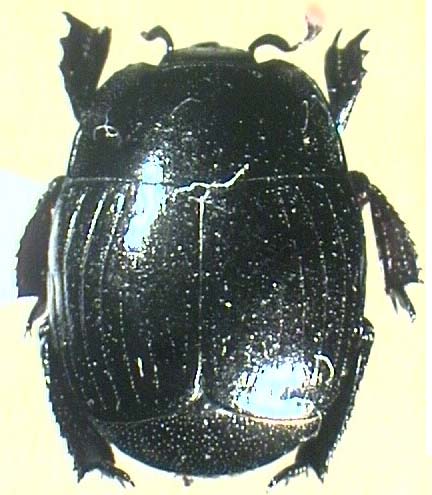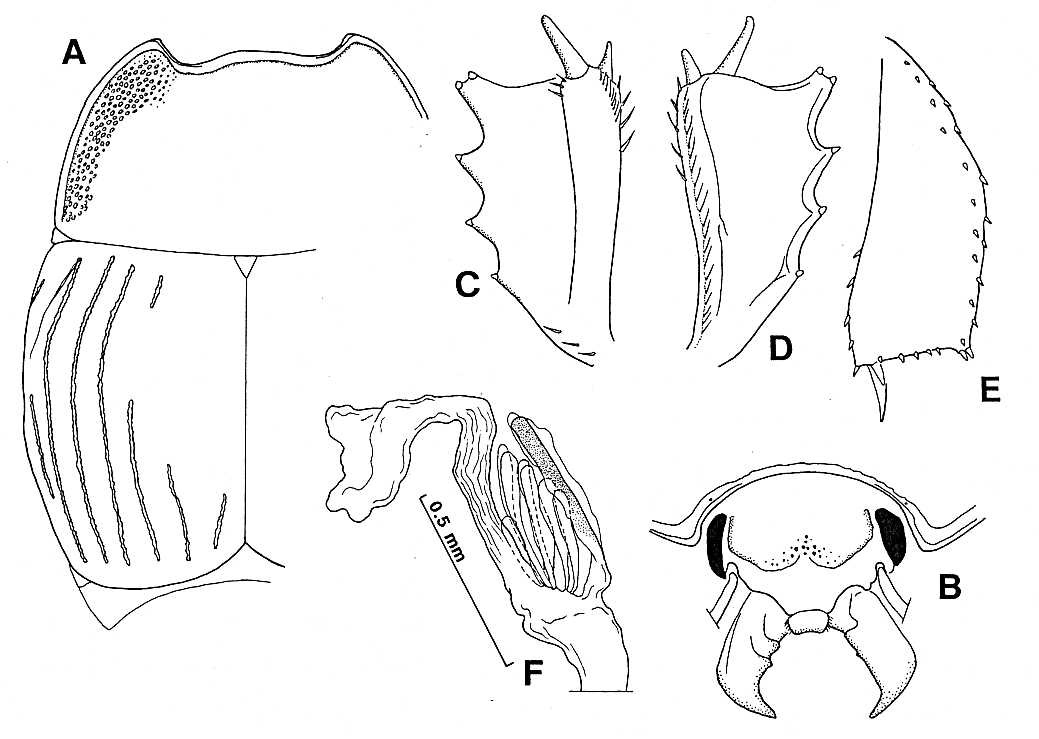

Merohister aino: Ohara, 1992, 385; 1994, 136.
Hister aino Lewis, 1884: 134 [Japan: Ishikari river in Yezo (= Hokkaidô)]; Lewis, 1905: t. 10, f. 3 [figure].
Hister (Hister) aino: Bickhardt, 1910: 40 [catalogued]; Desbordes, 1919: 385 [noted].
Hister (Merohister) aino: Bickhardt, 1917: 188.
Merohister jekeli: Bickhardt, 1918: 230; Kryzhanovskij and Reichardt, 1976: 304; Mazur, 1984: 201.
Merohister aino: Ôhara, 1992a: 385.
Japanese name: Ainu-emmamushi.
Description. Male and female. Body length, PPL 7.2 - 8.2 mm, PEL 6.0 - 6.9 mm. Width 5.05 - 5.9 mm. Biometric data are given in Table 2. Body oblong-oval, black and shining; tarsi and antennae dark brown.
Frontal stria of head (Fig. 4B) well impressed and usually narrowly interrupted at middle, sometimes complete (in the holotype). Disk of head sparsely clothed with fine punctures, the punctures coarser and denser in anterior area within the frontal stria (Fig. 4B).
Marginal pronotal stria (Fig. 4A) broadly interrupted behind the head, and complete laterally. Lateral pronotal stria complete, and close to the margin. Interval between the lateral stria and the margin distinctly convex. Disk of pronotum sparsely and finely punctate medially, but deep and rather coarse punctures present in a broad longitudinal area on each side within the lateral stria (Fig. 2F). Antescutellar area with a short longitudinal puncture.
Elytra (Fig. 4A) with a feeble subapical impression. Epipleural fossette densely covered with coarse punctures. Marginal epipleural and marginal elytral striae complete. External subhumeral stria present on basal half by an arc. Internal subhumeral stria on apical two-thirds, sometimes shorten apically. First - 3rd dorsal striae complete. Fourth dorsal stria variable, usually present on apical half, sometimes nearly entire but narrowly interrupted at basal two-thirds (according to the original description the dorsal stria is complete, but in fact it is narrowly interrupted in the holotype) or present on apical two-thirds, occasionally remained basal rudiment. Fifth dorsal and sutural striae present on apical fourth. Disk of elytra sparsely and finely punctate, the apical fifth sparsely covered with coarse punctures.
Pygidia with alutaceous ground sculpture. Propygidium (Fig.
2 C) sparsely covered with ocelloid and large punctures which
are separated by one to three times their diameters, the punctures
becoming denser laterally, and scattered with microscopic punctures
between ocelloid ones. Disk of propygidium deeply depressed on
each sides. Punctation of pygidium (Fig. 2 D) densely covered
with large and round punctures which are separated by about half
their diameter, and fine punctures intermingled with large ones.
Prosternal lobe narrowly truncate at apex, its marginal stria complete and well impressed, and another marginal stria present lateral three-fourths; disk of lobe densely and coarsely punctate laterally. Prosternal keel rather broad, without carinal stria. Lateral prosternal stria short and well impressed.
Anterior margin of mesosternum broadly and feebly emarginate at middle, its marginal stria complete. A short stria present between the marginal stria and antero-lateral angle on each side. Intercoxal disk of mesosternum sparsely clothed with microscopic punctures. Meso-metasternal stria complete, obtusely angulate at middle. Lateral stria of metasternum extending obliquely and posteriorly, and united with the oblique stria, which extends inwardly from the middle of metasternal-metepisternal suture. Intercoxal disk of metasternum sparsely clothed with microscopic punctures. Lateral disk of metasternum densely covered with large, shallow and round punctures, and medium-sized punctures intermingled with the large ones; basal area of the disk with hairs.
Intercoxal disk of 1st abdominal sternum usually with a stria in basal half on each side, sometimes the stria separated onto apical and basal halves; punctation of disk microscopic and sparse, the punctures becoming larger laterally and somewhat coarser on transverse apical band.
All tibiae dilated. Protibia (Fig. 4 C, D) with 5 denticles on outer margin, its apical angle "bifid" (bearing two denticles). Profemur with femoral stria on apical third.
Male genitalia as shown in Fig. 5.
Female genitalia as shown in Fig. 4F.
Remarks. Bickhardt (1918) treated aino as a synonym of jekeli. But judging from the holotype, aino is not a synonym of jekeli. This species is distinguished from jekeli by the body size small, the dorsal elytral striation different, the punctation of pronotum broad, and the front of head with large punctures within the frontal stria.
This species has been found on the trunk of decayed tree or in the nest of fish owl.
Specimens examined. Holotype, 3ÅâÅâ, 3 ÅäÅä and 1 ex.
Holotype (Fig. 2G, H): "Type"; Ishikari, 1883; G. Lewis coll., B. M. 1926-369; Hister aino Lewis, Type. (The National History Museum, London).
[Hokkaidô] 1 Åâ, Horokanai, Moshiri, 6/viii/1983, K. Hosokawa leg.; 1 ex., Metou-onsen, Asyoro, 30/v/1989, "in a nest of fish owl," Y. Hayashi, N. Kuhara and O. Suda leg. ; 1 Åâ, Mt. Moiwa, Sapporo, 8/vii/1954, M. Konishi leg. (EIHU); 1 Åä, Sapporo, 6/vi/1900, no collector's name (EIHU); 1 Åä, Hassabu, Sapporo, 25/vi/1914, Ishida leg. (EIHU).
[Honshû] <Fukushima-ken> 1 Åâ, Nanairi,
Hinoemata, 24/vi/1990, K. Tazoe leg. <Tochigi-ken> 1 Åä,
Marunuma, Nikkô, 23/vii/1959, S. Tsuyuki leg. (NSMT).
Japan: [Hokkaido] Proper: Kanoko-dame, Oketo-chô (1 ex., 8-20/vii/1994, HOR), S. Hori.
[Honshu] Iwate-ken: Hakogamori (Dougamori), Morioka City (1 ex., , 3/vii-5/viii/1993, collection of Dr. T. Oku), I. Date.
